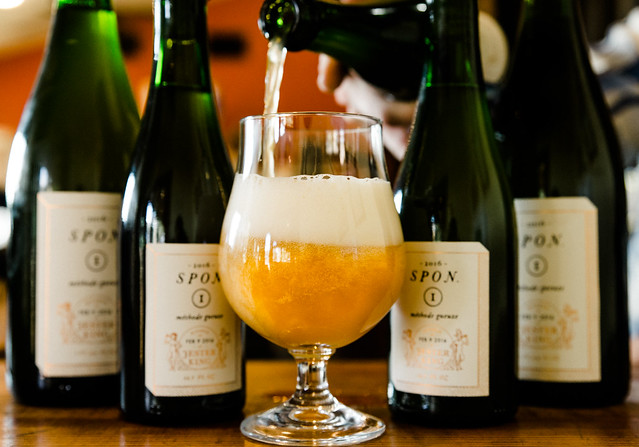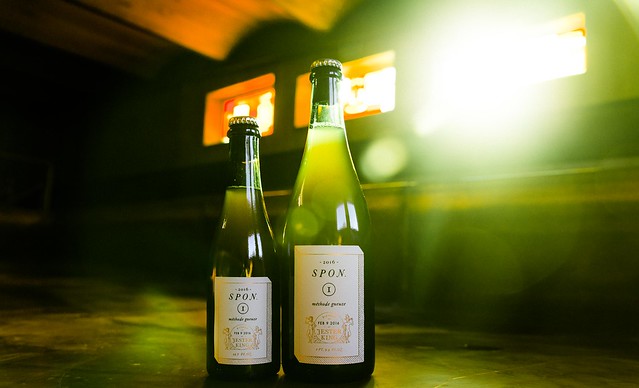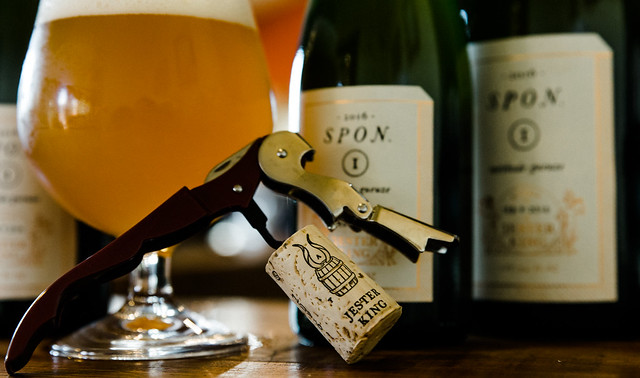Introducing Jester King 2016 SPON — Méthode Gueuze
February 24, 2017
We’re very excited and proud to announce the release of Jester King 2016 SPON — Méthode Gueuze, our first ever 100% spontaneously fermented beer. Jester King 2016 SPON — Méthode Gueuze is a blend of one, two, and three year old 100% spontaneously fermented beer made using the traditional method of authentic Belgian Gueuze.
The Origin
During the fall of 2012, we visited Brasserie Cantillon in Brussels, Belgium for the first time and came home inspired to see if spontaneously fermented beer could be made in Texas. We weren’t alone in our doubts. Several of our respected peers voiced concerns about the balance of microflora in our hot climate. We figured we had nothing to lose and that it would be a fun experiment, so on February 26th, 2013, we brewed our very first batch of 100% spontaneously fermented beer inspired by the tradition of authentic Belgian Gueuze.

Brothers Michael Steffing & Jeffrey Stuffings during their visit to Brasserie Cantillon
The Method
Our first brew was a turbid mash of 60% malted barley and 40% raw Texas wheat. We followed the mash schedule found in Jeff Sparrow’s Wild Brews. The first runnings were very starchy. We boiled the wort for four hours with hops aged in burlap bags in the attic of our horse barn.

We transferred the entire batch of wort to a ~15 barrel coolship we had fabricated out of stainless steel. We let the wort cool overnight exposed to airborne yeast and bacteria. The next day, we racked the cooled wort to oak puncheons without pitching any yeast or bacteria. We then waited patiently to see if anything would happen.

First coolship fill, February 26, 2013
After about a week, and much to our amazement, the wort started to ferment. Early on, the beer was very harsh, astringent, and bitter. It had an unpleasant grainy character, smelled like cooked corn, and was very turbid. The only thing that gave us hope at that point, was the beer still tasted pretty “clean” despite the astringency and noticeable off-flavors. But then, after about six months, we noticed a transformation. The grainy, cooked corn aroma gave way to a very pleasant musty attic, barnyard scent. The bitterness still lingered, but the astringency had mellowed. We could tell the beer was slowly becoming more refined as it aged. This gave us hope — enough hope that we were encouraged to try spontaneous fermentation again the following winter.

First ever sign of spontaneous fermentation at Jester King, March 4th, 2013
The winter of 2014 marked our second coolship season. Unlike our first season in 2013, where we only did two 15 barrel batches, we did around a dozen coolship brews the second season. Fermentation was vigorous, and the beer overall was less bitter and more sour than 2013. We believe this had to do with decreasing our hopping rate for our second season. We used around 0.75 pounds per barrel of hops rather than 1.25 pounds per barrel. We also think our aged hops had less bitterness after another full year aging in the attic of the horse barn.
Our third coolship season began in January, 2015. By this point, we were pretty confident the wort would spontaneously ferment and slowly mature over time. We felt we hit our sweet spot in terms of our hopping rate, settling around one pound per barrel. Balancing acidity is a critical part of what we do, and we really like the soft, restrained acidity from our 2015 coolship season.

Spontaneous fermentation from the 2014 season
Finally, in February of 2016 we created our first blend! We took ten percent beer from 2013, thirty percent beer from 2014, and sixty percent beer from 2015, blended it, then packaged it in bottles and kegs. We did not pitch any yeast or bacteria at the time of bottling, but rather relied on the microbes still alive in the beer for refermentation. We did however add a dose of priming sugar at the time of packaging. We experimented with refermenting the blend using the residual sugar in the younger beer. However, this technique did not produce the level of carbonation we wanted. We refermented the bottles on their sides. Not only is this true to the traditional method of Gueuze, but we’ve become huge proponents of shallow vessel fermentation on a sensory level.

Bottles of 2016 SPON — Méthode Gueuze conditioning on their side
The three year blend has been slowly maturing in bottles since February, 2016 and will be nine months old at the time of release. Extended refermentation and maturation in the serving vessel is another technique that’s true to the method of Gueuze, which we find absolutely critical. A lot of the funky, basement cellar, musty attic aromas that we love simply are not present at the time of blending and need time in the bottle to develop. In our opinion, there is no substitute for extended refermentation / maturation for beers of this style.
The Name
That brings us to our decision to call our three year spontaneous blend “2016 SPON — Méthode Gueuze”. We’ve struggled mightily with what to call this beer for a few years now. As a starting point, we knew we would not claim that it was an authentic “Lambic” or “Gueuze”. Our beer was made in Texas. Lambic and Gueuze come from Brussels and the Pajottenland. End of story. We make no claim of authenticity whatsoever when it comes to “Lambic” or “Gueuze”. Our beer is NOT “Lambic” or “Gueuze”.
Rather, we have a very strong desire for beer drinkers to know how our beer was made. We want them to know that this is not just a spontaneously fermented beer, but a spontaneously fermented beer made using the method of authentic Belgian Gueuze. We invested an inordinate amount of time, energy, money, and patience into making this beer. The work began all the way back in 2012. The beer itself took three years and nine months to make. Aside from the cost of the equipment and raw materials for our spontaneous program, we’ve sacrificed who knows how much opportunity cost by devoting a huge portion of our barrel room to spontaneous fermentation — space that could have been used for far less time intensive beer. We feel we’d be doing ourselves a disservice by just calling our beer “spontaneous” or “coolship ale”. For instance, a very delicious, well-executed Berliner Weisse can be “spontaneously fermented” and ready to drink in just days! We felt a compelling need not to stop short at the terms “spontaneous” or “coolship” in order for beer drinkers to truly understand the steps we’ve taken.
How to do this, however, was a challenge. We needed to find a way to sum up a verbose description — a naturally conditioned blend of three, two, and one year old 100% spontaneously beer, made with a grist of malted barley and raw wheat, turbid mashed, and boiled for hours with aged hops, chilled and inoculated overnight in a coolship, and fermented in oak barrels without the addition of any microorganisms or chemicals — with a simple, artful word or phrase. We wanted a mere word or phrase where beer drinkers would know our inspiration and process simply by seeing it. For help with this problem, we reached out to a friend, confidant, and the modern day godfather of authentic Lambic and Gueuze — Jean Van Roy of Brasserie Cantillon.
We posed this dilemma to Jean, and he graciously responded by suggesting the establishment of “Méthode Gueuze”. According to Jean:
“Your blend deserves even more to be called ‘Lambic’ or ‘Gueuze’ than a lot of fake Belgian Gueuze. The way to use ‘Méthode Gueuze’ is a bit the same used in the wine world for some sparkling wine. The most well known being Méthode Champenoise.”
As Jean said, Méthode Gueuze is analogous to “Méthode Champenoise”. Its function is to explain and certify how a particular beer was made — in this case one that follows the traditional method of making authentic Gueuze.
In the coming weeks and months, we plan on working with Jean and other authentic makers of Lambic and Gueuze, as well as other brewers from around the world to establish “Méthode Gueuze” as a Certification Mark. The mark, pictured below, will verify that a certain set of standards and criteria are met during the making of the beer, namely a traditional grist of malted barley and raw wheat, a turbid mash and extended boil with aged hops, overnight cooling and inoculation of the entire batch of wort in a coolship or similar vessel, 100% spontaneous fermentation in oak barrels, a blend of one, two, and three year old barrels or older, and 100% natural refermentation.

Admittedly, this is a more ambitious undertaking than we ever dreamed of when we started this process four years ago. But the cause has become very dear and close to home for us. Based on what we’ve observed in the beer community, it seems that right now, we’re on the crest of a giant new wave of spontaneously fermented beer that’s soon to come crashing down into the market. This is a good thing, so long as the quality is there! A world-wide resurgence of spontaneous fermentation, if anything, is a reversion back to how much of beer was fermented centuries ago. It also helps create regional distinctions, terroir, and a sense of place in beer. I don’t begrudge this in the slightest, and like I said, see it as a good thing.
But like anything with lots of momentum behind it, there’s a natural flow toward what is cheaper and more expedient. That’s why we, and many of our peers, have a desire to see that at least certain standards and traditional methods actually mean something. That doesn’t mean that a spontaneously fermented beer must be “Méthode Gueuze” to be good. Far from it. But we do believe that certain traditional methods need attention and care, lest they become so watered down, confused, and bastardized that they essentially become meaningless.
Acknowledgements
We will be releasing 2016 SPON — Méthode Gueuze at Jester King on Friday, November 18th. We will announce release details soon. But for now, we want to thank all the people who made the beer possible.
The beer industry is filled with a wonderful collection of fantastic people, and we’re grateful to have the help and support of so many of them. Here’s a list of people we want to thank in alphabetical order by last name, who helped play a role in the creation of SPON — Méthode Gueuze:
Tim Adams, Josh Amos, Luis Aparicio, Adrienne Ballou, Todd Boera, Mikkel Borg Bjergsø, Chris Booth, Frederique Boudouani, Jon Buford, Mike Calles, Alberto Carduus, Troy Casey, Aaron Chamberlain, Vinnie Cilurzo, Constanze Chicon, Josh Cockrell, Garrett Crowell, Yvan De Baets, Nic De La Rosa, Walt Dickinson, Greg Engert, Ron Extract, Gabe Fletcher, Levi Funk, Jay Goodwin, Christian Gregory, Chase Healey, Evan Hill, Shaun Hill, Allison Huffman, Jean Hummler, Jeppe Jarnit-Bjergsø, Ron Jeffries, Carson Jewell, Khris Johnson, Brandon Jones, Marika Josephson, Jordan Keeper, Cory King, Karen King, Aaron Kleidon, Eric Kukla, Jake Maddux, Joe Madia, Tyler Malone, Sara Maya, Raphael Mettler, Marco Rodriguez, Marc Nelipovich, Adair Paterno, Jason Perkins, Sean Phillips, Matt Piper, Walt Powell, Josh Wilson, Joel Richards, Lindsey Rogers, Trevor Rogers, John Rubio, Ismael Salas, Lauren Salazar, Zach Schroeder, Daniel Shelton, Bob Sylvester, Jeff Sparrow, Sean Spiller, Josh Spradling, Ian Steigmeyer, Amber Stuffings, Brian Sublette, Averie Swanson, Daniel Thiriez, Rob Tod, Michael Tonsmeire, Chris Troutman, Jean Van Roy, Alex Wallash, Patrick Ware, Amber Watts, Kyle White, Alex Williams, Shane Winkler, Phil Wymore, Chad Yakobson, Bill Young, Nathan Zeender
The artwork for SPON — Méthode Gueuze was created in-house by Josh Cockrell.
Obviously, this is a long post with a lot of info. If anyone has any questions or comments about any of the topics in this post, please feel free to contact me directly via e-mail (jstuffings @jesterkingbrewery.com) or phone (512-364-7278).
Thanks for your time and attention! We’re very excited about the release next month and the upcoming work regarding the Méthode Gueuze certification mark.
Cheers,
Jeffrey Stuffings
Founder
Jester King Brewery
P.S. Below are photographs of 2016 SPON — Méthode Gueuze and the process that went into making it!

Coolship installation in 2013 with Ismael Salas

Water test batch

First coolship fill

Night of first coolship fill with Jordan Keeper, Garrett Crowell, Adrienne Ballou, Josh Cockrell (l to r)

First coolship empty

Krausen

Spontaneous fermentation

Early coolship fill

Pyramid stacks

Barrel stacking with Garrett Crowell, Matt Piper, and Ismael Salas (l to r)

Barrel placing with Matt Piper

Garrett Crowell barrel filling

2015 spontaneous season

New puncheons with Matt Piper

Coolship prep with Garrett Crowell and Ron Extract (l to r)

Barrel placing with Marco Rodriguez (front)

“Knockout into a coolship!”

Marco Rodriguez, Adrienne Ballou, Jordan Keeper, Averie Swanson, Ian Steigmeyer, Garrett Crowell (l to r)

Allison Huffman cleaning the coolship

Moving the coolship out of the barrel room at season’s end

Coolship loft roof buildout with Josh Cockrell and Matt Piper (l to r)

New coolship construction with Michael Steffing and Evan Hill (l to r)

New coolship for 2016

New coolship water test with Ian Steigmeyer

First test blend

My daughter Laura Stuffings on first spontaneous brewday

Laura Stuffings today



